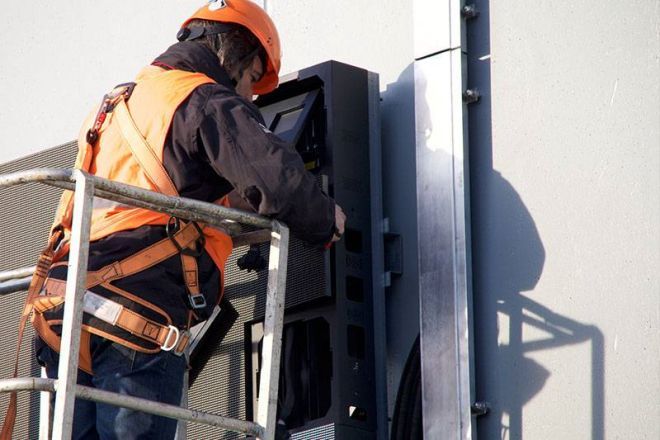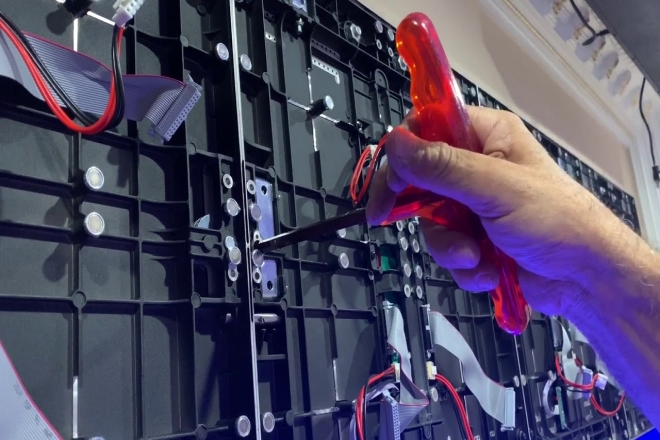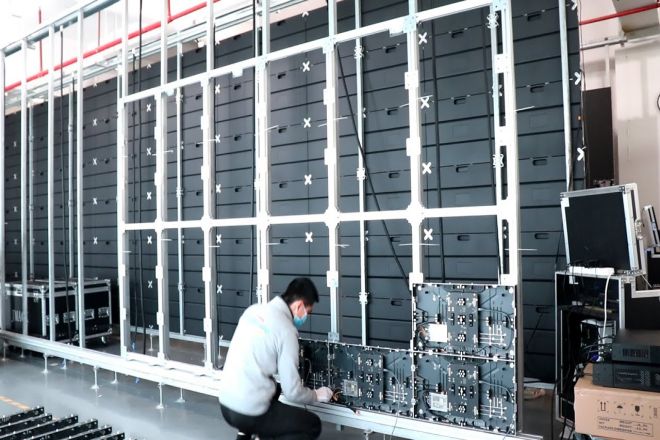Introducción

Have you ever stood in front of a dazzling Pantalla LED, shocked by its visual feast, but never thought about the many challenges in the installation process behind it?
On the road to pursuing perfect display effects, installation errors are often the stumbling block that cannot be ignored. From negligence in preliminary preparation to detailed errors in the installation process to neglect of later maintenance, each error may greatly reduce the carefully planned display plan.
So, are you eager to know how to avoid these “pitfalls” so that your LED display installation project can proceed smoothly?
This article will take you directly to the common mistakes in LED display installation. Through in-depth analysis and practical suggestions, you will be confident in every step of the installation and ensure that the final display effect is beyond imagination.
1. Insufficient preliminary preparation
1). Demand analysis: a bridge from vague to clear
- Entrevista en profundidad:
We are like delicate painters, working with customers to outline the outline of the needs, not only outlining the basic display needs, but also capturing the expectations hidden behind them in detail, such as scalability, budget considerations and maintenance convenience.
- Case display:
By showing successful cases of similar projects, we open a window for customers to intuitively feel the actual effects of different solutions, so that they can make more wise choices.
- Written confirmation:
This demand document, carefully crafted by both parties, as the hands of both parties clenched tightly, confirms the common goals and expectations and lays a solid foundation for subsequent design and construction.
2). Site survey: A journey where details determine success or failure
- Comprehensive investigation:
Like detectives, we carefully search every corner of the site, record the size and load-bearing information, and also do not forget to explore key factors such as electricity, network, ventilation, etc., to ensure that nothing is missed.
- Environmental simulation:
Using professional software, we seem to have the ability to predict the future, simulate the performance of display screens under various natural conditions, and prepare for challenges.
- Evaluación de riesgos:
Based on the survey, we, like navigators, identify and evaluate the risks that may be encountered, formulate response strategies, and ensure a smooth journey.
3). Design planning: A symphony of art and technology
- Diseño profesional:
We hire experienced designers, like conductors, to cleverly combine the results of on-site surveys with customer needs to compose a scientific and reasonable design movement.
- Multi-party collaboration:
Architects, structural engineers and other experts are like various instruments in the band, participating in this creation together to ensure that the display is both beautiful and safe and meets all technical specifications.
- Simulation display:
Using 3D modeling or virtual reality technology, we present a realistic preview screen to customers, allowing them to feel as if they are in a future scene and experience the visual feast brought by the display.
- Flexible adjustment:
During the design process, we maintain the sensitivity and flexibility of artists and adjust the design plan in time according to on-site feedback and customer needs to ensure the perfect presentation of the final work.
2. The installation process of LED display is not standardized

1). Foundation construction: Build a solid foundation as stable as Mount Tai
Construction drawing review: Before construction, we send experienced engineers, like craftsmen, under a magnifying glass to examine the construction drawings word by word to ensure that every stroke draws a safe blueprint.
Material quality control: Select superior building materials, such as steel-like tough steel and the best in concrete, which together build a solid foundation for the display.
Construction supervision: On site, we set up “quality sentinels” who closely monitor the construction details to ensure that every shovel of soil and every steel bar is accurate and in place, following the dual guidance of drawings and technology.
Acceptance test: After the installation was completed, we conducted a “stress test” to ensure that the foundation of the display screen was as solid as a rock and was not afraid of wind and rain through multi-dimensional tests such as load-bearing and stability.
2). Line connection: precise weaving and unobstructed
Standardized wiring: We have drawn a clear “line map” to clarify the trajectory and intersection of each line so that the power line and the signal line are in their proper place and in order.
Professional training: After careful carving, the installers have become “experts” inline connections. They are familiar with the temperament of each line and ensure that the connection is accurate and operates like precision machinery.
Logo management: Each line has a unique “identity card,” and the clear logos at both ends are like road signs, guiding each step of subsequent maintenance.
Inspection and verification: After the connection is completed, we started the “line detective” mode and used professional tools to check one by one to ensure that each line is unobstructed, without short circuits or open circuits.
3). Waterproof and dustproof: airtight, clean as before
Waterproof and dustproof design: At the beginning of the design, we put on a “protective suit” for the display screen, using high-sealing materials and a carefully designed structure to keep wind, rain, and dust away.
Professional installation: During the installation process, we are as meticulous as embroidery, ensuring that every interface and every gap are tightly closed, so that the display screen can be safe and sound in harsh environments.
Regular inspection: We have set up a “health check day” to conduct a comprehensive physical examination of the waterproof and dustproof device of the display screen regularly to detect and eliminate potential threats in time.
Emergency handling: In the face of emergencies, we are well prepared. The emergency plan is like an emergency rescue team. Once the display screen is found to be in trouble, it will be immediately activated to quickly restore its “innocence”.
3. The installation, debugging, and acceptance of LED display screens are not rigorous
In response to the problem of lax installation, debugging, and acceptance of LED display screens, we need to build a rigorous and systematic operation process to ensure that every step is accurate and correct. The following is a refinement of the avoidance strategy you proposed:
1). Display effect: pursuit of perfection beyond expectations
Elite debugging team: We have carefully formed a team of “color magicians” composed of industry leaders who are good at capturing the subtle changes of light and shadow and giving life to the display screen.
All-round debugging: From basic brightness and contrast to advanced color temperature, ángulo de visión, y frecuencia de actualización, we are as meticulous as painters, striving to make every frame of the picture reach the level of a visual feast.
Real-scene simulation field: On the debugging stage, we set up scenes that simulate the real world one by one so that the display screen can show its best style under different lights and angles.
Customer appreciation meeting: When the debugging movement comes to an end, we sincerely invite customers to come to the scene to witness and confirm this visual masterpiece that exceeds expectations.
2). Functional testing: comprehensive coverage, no omissions
Functional blueprint: At the beginning of the project, we worked with customers to draw a detailed functional blueprint to ensure that every detail is clearly visible and without omissions.
Test navigation map: Based on the functional blueprint, we developed a detailed test plan, which guides the direction of the test like a nautical chart to ensure that every step is accurate.
Automated cruising: With the help of advanced automated testing tools, we are like having a pair of wise eyes, quickly and accurately traversing the various functions of the display.
Manual exploration: For those secrets that require manual intervention, we personally go into battle and conduct meticulous manual verification to ensure that every place shines with the light of function.
Issue tracker: During the test journey, we are equipped with an issue tracker to record every “episode” found and chase them until they disappear.
3). Acceptance criteria: clear definition and fair judgment
Standard consensus: At the beginning of the project, we drew a blueprint for acceptance with customers and clarified the measurement scale and judgment criteria for each indicator.
Standard Ambassadors: We have equipped the acceptance team with “Standard Ambassadors” who spread the acceptance criteria like missionaries to ensure that every member understands.
Phase Milestones: The project is cleverly divided into multiple stages, and each stage has clear acceptance milestones. We are like climbers, moving step by step towards the top.
Third-party arbitration: At critical moments, we invite third-party testing agencies as fair arbitrators. They measure the performance and functions of the display like a scale to ensure that the acceptance results are indisputable.
Acceptance Certificate: When all efforts converge into a river, we write a detailed acceptance report and attach a heavy acceptance certificate, which witnesses the perfect birth of the display like a medal of honor.
4. Lack of post-maintenance and maintenance

In response to the problem of insufficient post-maintenance and maintenance of LED display screens, we are committed to building a comprehensive and efficient maintenance system to ensure that the display screen can shine for a long time and operate stably.
The following is an in-depth refinement and beautification of the avoidance strategy:
1). Fill the gap in regular inspections: Build a preventive maintenance network
Customized maintenance blueprint: According to the unique operating environment and usage frequency of the display screen, tailor-make the maintenance plan, set a scientific and reasonable inspection cycle and detailed maintenance points.
Professional guardian training: The maintenance team receives comprehensive professional training and becomes the “internist” of the display screen, who is well versed in its internal structure and operation and maintenance methods and has superb skills.
Inspection log: The mark of time: For each inspection, we leave a detailed “health file” to record every diagnosis and treatment to protect the long-term health of the display screen.
Cleaning and tightening: Rejuvenation: Regularly deep clean the display screen, wipe off the dust, and restore its bright color. At the same time, tighten every screw to ensure that the structure is as stable as Mount Tai.
2). Accelerate fault response: Establish a lightning rescue team
Instant communication chain: Build a “green channel” for fault reporting to ensure that information is unimpeded and maintenance personnel can respond the first time to start the maintenance “engine.”
Precise positioning and rapid repair: After arriving at the scene, the maintenance personnel turned into “detectives” to quickly identify the source of the fault and take targeted measures to restore the vitality of the display screen.
Fault files: A mirror of history: Record every fault and its handling process in detail as a valuable experience library to provide reference and warning for the future.
Prepare for a rainy day: Prevention is better than cure. For common “symptoms,” formulate preventive measures, such as regular “physical examinations” of vulnerable parts, optimize the operating environment, and leave faults nowhere to hide.
3). Ensure sufficient spare parts: Build a solid backing
Spare parts warehouse: Emergency granary: According to the configuration of the display screen, establish a complete spare parts inventory system to ensure sufficient “ammunition” and be on standby at any time.
Regular inventory: Ensure foolproof: Regularly inventory spare parts, just like military equipment inspection, to ensure that each spare part is in the best condition.
Reliable partner network: Work with the industry’s top suppliers to build a stable supply chain system to ensure that the required spare parts can be quickly obtained at critical moments.
Spare parts usage tracking: The track of each screw: Recording the use of spare parts is like tracking the footprints of soldiers, providing data support for optimizing spare parts management.
Conclusión
In summary, common errors in the installation process of LED display screens cannot be ignored. They are not only related to the display effect and service life of the display screen but also directly affect the user experience and safety.
By strengthening preliminary preparations, standardizing the installation process, rigorous debugging and acceptance, and doing a good job of post-maintenance and maintenance; we can effectively avoid these errors and improve the installation quality and service level of LED display screens.
At the same time, we should continue to learn and explore new technologies and methods to adapt to the rapid development and changes in the LED display industry.
Finalmente, si quieres saber más sobre las pantallas LED, Por favor póngase en contacto con nosotros.
